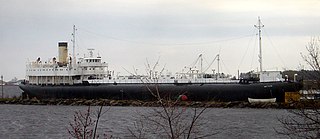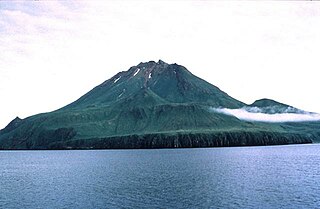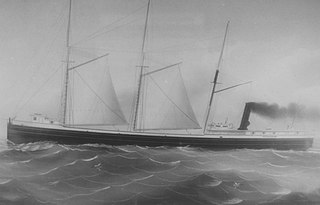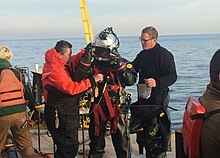
USS Mississinewa (AO-59) was the first of two United States Navy ships of the name. She was a T3-S2-A1 auxiliary oiler of the US Navy, laid down on 5 October 1943 by the Bethlehem Sparrows Point Shipyard, Inc., Sparrows Point, Maryland; launched on 28 March 1944; sponsored by Miss Margaret Pence; and commissioned on 18 May 1944. Mississinewa was commanded by Captain Philip G. Beck. The ship is named for the Mississinewa River of eastern Indiana.

USCGC Mesquite (WAGL/WLB-305) was the lead ship in the Mesquite class of seagoing buoy tenders operated by the United States Coast Guard. She served in the Pacific during World War II, and spent the rest of her Coast Guard career in the Great Lakes. She ran aground and was wrecked in December 1989 off the Keweenaw Peninsula in Lake Superior. She was scuttled nearby as a recreational diving attraction.

Lake freighters, or lakers, are bulk carrier vessels that operate on the Great Lakes of North America. These vessels are traditionally called boats, although classified as ships.

Edward M. Cotter is a fireboat in use by the Buffalo Fire Department at Buffalo, New York, United States. Originally named William S. Grattan, it was built in 1900 by the Crescent Shipyard of Elizabeth Port, New Jersey. Due to age, it was rebuilt in 1953 and renamed Firefighter upon its return to service. The following year it was renamed Edward M. Cotter. its namesake, Edward Cotter, was a Buffalo firefighter and leader of the local firefighters union who had recently died.

SSMeteor is the sole surviving ship of the unconventional "whaleback" design. The design, created by Scottish captain Alexander McDougall, enabled her to carry a maximum amount of cargo with a minimum of draft. Meteor was built in 1896 in Superior, Wisconsin, United States, and, with a number of modifications, sailed until 1969. She is now a museum ship in the city of her construction.

Uliaga Island is the northernmost member of the Islands of the Four Mountains group in the Aleutian Islands of southwestern Alaska. The island's name is probably derived from the Aleut place name ulaĝa, which is itself derived from ulaẍ - "bearberry." The triangular shaped island measures about 2.4 miles (3.9 km) across and consists of a single stratovolcano cone that reaches a height of 2,913 feet (888 m). The island has an area of 3.44 square miles (8.9 km2). No eruptions have been recorded in historical times, though it is thought to have been active at some time during the Holocene Epoch.

The John M. Osborn was a wooden steam barge that sank in Lake Superior in 1884 with the loss of five lives. The Osborn was just 2 years old when the larger, steel-hulled Alberta, which was called a "steel monster" and "terror of the lakes", rammed her. The wreck of the Osborn was discovered 100 years after her sinking. The wreck was illegally salvaged in the 1980s. Many of Osborn's artifacts became the property of the State of Michigan after they were seized from Great Lakes Shipwreck Museum. The State allows the museum to display the artifacts as a loan. The wreck of the Osborn is now protected by the Whitefish Point Underwater Preserve as part of an underwater museum.

SS M.M. Drake was a wooden steam barge that towed consorts loaded with coal and iron ore on the Great Lakes. She came to the rescue of the crews of at least four foundering vessels in her 19-year career only to meet the same fate in her final rescue attempt. Drake sank in 1901 off Vermilion Point after a rescue attempt of her consort Michigan. Her rudder, anchor, and windlass were illegally removed from her wreck site in the 1980s. They are now the property of the State of Michigan. The rudder is on display as a loan to the Great Lakes Shipwreck Museum and the anchor and windlass are on loan for display to Whitefish Township Community Center. The wreck of Drake is protected as part of an underwater museum in the Whitefish Point Underwater Preserve.

Home was a two-masted schooner which sank in Lake Michigan off Centerville in Manitowoc County, Wisconsin, United States, in 1858. In 2010 the shipwreck site was added to the National Register of Historic Places.
The SS Arrow was an oil tanker built by Bethlehem Steel Company, Sparrows Point, Baltimore, Maryland in 1948 as the tanker Olympic Games. Renamed Sea Robin in 1960 and finally Arrow in 1962, the ship was a Liberian-registered tanker owned by the Sun Navigation Company. At 551.2 feet in length and 68.3 feet in width, with a draft of 29.9 feet, she was an enlarged version of the standard American World War II tanker design and one of the oldest tankers in the fleet of Aristotle Onassis. The Arrow ran aground and spilled its load of oil into Chedabucto Bay on February 4, 1970. This remains the most significant oil spill off Canada’s East Coast, with some 10,000 tonnes. Only the MV Kurdistan accident has come close, spilling about 6,000 tons of oil after breaking apart in the Cabot Strait on March 15, 1979.

SS Robert Wallace was a wooden-hulled American bulk freighter that served on the Great Lakes of North America from her construction in 1882 to her sinking in 1902 on Lake Superior near the town of Palmers, St. Louis County, Minnesota, United States. On November 17, 1902 shortly after leaving Superior, Wisconsin with a cargo of iron ore, Robert Wallace sprang a leak and sank. Her wreck was found in 2006, and on October 14, 2009, the wreck of Robert Wallace was listed in the National Register of Historic Places.

The SS Lakeland was an early steel-hulled Great Lakes freighter that sank on December 3, 1924, into 205 feet (62 m) of water on Lake Michigan near Sturgeon Bay, Door County, Wisconsin, United States, after she sprang a leak. On July 7, 2015, the wreck of the Lakeland was added to the National Register of Historic Places.

SS Selah Chamberlain was a wooden-hulled Great Lakes freighter that sank in Lake Michigan in 1886, 6 miles (10 km) off the coast of Sheboygan, Sheboygan County, Wisconsin, United States after being rammed by the steamer John Pridgeon Jr. with the loss of five lives. On January 7, 2019, the wreck of Selah Chamberlain was listed on the National Register of Historic Places, and was given the reference number 100003288. She was the first shipwreck listed on the National Register of Historic Places in 2019.

The MV Golden Ray was a 200-metre long (660 ft) roll-on/roll-off cargo ship designed to carry automobiles that capsized on 8 September 2019 in St. Simons Sound near the Port of Brunswick in Georgia, United States. She was eventually declared a total loss and was removed as scrap.

The Wisconsin Shipwreck Coast National Marine Sanctuary is one of 15 United States National Marine Sanctuaries administered by the National Oceanic and Atmospheric Administration (NOAA), an agency of the United States Department of Commerce; NOAA co-manages the sanctuary jointly with the State of Wisconsin. It is located in Lake Michigan along the coast of Wisconsin. It was created in 2021 to protect shipwrecks considered nationally important archaeological resources.

















